Timberwolf Firewood Processors Review 2024
- November 16, 2023
- 0 comment
When it comes to processing firewood, efficiency and power are of paramount importance. Timberwolf offers a range of firewood processors designed to meet the needs of various scales of operations, from small-scale residential use to industrial production. In this article, we will explore the features and specifications of each category of Timberwolf’s firewood processors.
About Timberwolf Firewood Processing Equipment
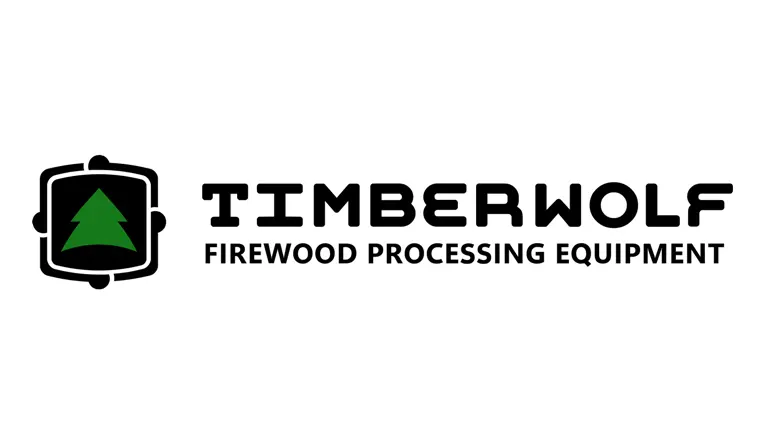
Timberwolf Firewood Processing Equipment, a subsidiary of Automated Biomass Systems, LLC, under the leadership of President Matthieu Timmins, has distinguished itself in the forestry and biomass processing industry for its innovative and efficient firewood splitters, conveyors, processors, and other equipment. Emphasizing unique design changes to maximize productivity, Timberwolf has recently undergone significant expansion, doubling its workforce and extending its operational space to over 70,000 square feet. This growth includes a strategic move into the Syracuse area with a new location, while retaining its headquarters in Marathon, NY, showcasing the company’s commitment to meeting increasing market demand and maintaining its reputation as a key player in the firewood processing equipment market.
What is a Firewood Processor?
A firewood processor is a piece of heavy machinery used for cutting and splitting large volumes of firewood efficiently. These machines are designed to take whole logs and convert them into firewood of a consistent size and length, automating tasks that would otherwise require manual labor with a chainsaw and a log splitter.
Here’s how a typical firewood processor works:
- Feeding: Logs are loaded onto a deck or trough, usually by a conveyor system or with a front-end loader.
- Cutting: A saw, typically a chainsaw blade or circular saw, is used to cut the log into sections of a predetermined length. This is often controlled by a hydraulic system.
- Splitting: After the log is cut, the resulting sections are moved to a splitting chamber where a hydraulic ram forces them through a wedge, splitting them into smaller firewood pieces.
- Ejecting: The split firewood is then conveyed away from the machine, often onto another conveyor belt that stacks the wood or loads it for transport.
The benefits of a firewood processor include:
- They can process large amounts of wood much faster than manual methods.
- They produce uniformly sized firewood, which is important for commercial sales.
- They reduce the risk of injury associated with using chainsaws and manual splitters.
- Although there is an initial investment, the labor cost savings and increased productivity can be significant.
Best Firewood Processor 2024
Small Scale: Timberwolf PRO-MP
Quick Specifications
- Engine Power (HP): 22
- Pump Flow (GPM): 22
- Stroke (in): 26
- Trough Length (ft): 16
- Max Log Length (ft): 32
- Cycle Time (sec): 5/7
- Average Output (Cord/Hr): 1.5
- Weight (lbs): 5,500
Timberwolf’s PRO-MP firewood processor blends portability with robust performance, making it an exceptional choice for small-scale operations. This processor deftly handles logs up to 32 feet long and 24 inches in diameter with its patented top roll clamping system and hourglass-shaped back roller, rivaling the capability of its more expensive counterparts. The ease of transport is a standout feature—weighing just 5,500 pounds, it can be towed by any half-ton truck, simplifying relocation and reducing overhead costs associated with log transportation.

At the heart of the PRO-MP lies a reliable 22 HP GX700 Honda engine, driving a 22 GPM Anfield gear pump that powers either a 4″ or 5″ cylinder. This design choice provides the flexibility to balance cycle time and splitting force, ensuring efficiency whether dealing with smaller logs or larger, tougher ones. Manual autocycle controls keep operation straightforward and productive, with an average output of 1.5 cords per hour—a notable achievement for a processor touted for its simplicity and manageability.

Durability and safety are central to the PRO-MP’s design, with heavy-duty Continental hoses ensuring high-pressure fluid handling without the risk of abrasion or leaks. The hydraulic system’s health is maintained by a 30-gallon tank, optimized for thermal efficiency, prolonging component life and ensuring consistent performance. The inclusion of a hydraulic wedge lift and a live deck that can be hydraulically raised or lowered epitomizes Timberwolf’s dedication to operator convenience and ease of use.
In summary, the Timberwolf PRO-MP is a versatile and economical firewood processor that doesn’t skimp on power or features. It’s designed for ease of use, safety, and longevity, making it an excellent investment for those needing reliable firewood processing without the complexities of larger, more industrial models. Its thoughtful design and solid construction promise to keep it a vital part of any small-scale firewood operation for years to come.
Medium Scale: Timberwolf PRO-HD
Quick Specifications
- Engine Power (HP): 56
- Pump Flow (GPM): 22-22-18
- Stroke (in): 26
- Trough Length (ft): 16
- Max Log Length (ft): 32
- Cycle Time (sec): 5.9/9.1
- Average Output (Cord/Hr): 2.5
- Weight (lbs): 9,200
The Timberwolf PRO-HD emerges as a mid-scale firewood processor designed to address common inconveniences found in other processors, offering a blend of power, efficiency, and innovation. This processor’s patented top roll clamping system exerts 1,000 pounds of downward pressure to secure logs for cutting, eliminating repetitive saw engagement and ensuring logs are centered for splitting. Combined with an hourglass-shaped back roller, it effortlessly manages logs up to 32 feet long, which translates to high-quality processed firewood with minimal operator interference.
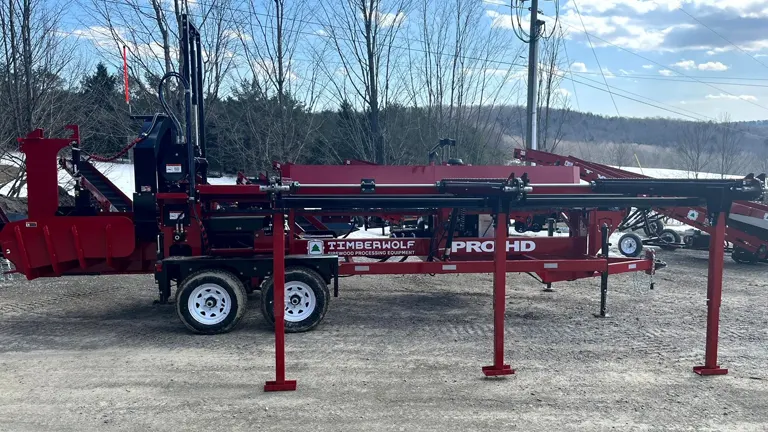
At the core of the PRO-HD is a robust 56 HP Hatz diesel engine, which, along with a 3-stage Permco gear pump, drives the machine’s multiple functions. With pump flows of 22 GPM for the splitter and saw, and 18 GPM for auxiliary functions, operators can multitask effectively, handling log cutting and driving the push block simultaneously. This functionality is further enhanced by the processor’s regenerative manifold and 2:1 cylinder ratio, yielding rapid cycle times and an impressive average output of 2.5 cords per hour, maximizing productivity.
The PRO-HD’s hydraulic system is equally noteworthy. A sizeable 70-gallon hydraulic tank equipped with internal baffles ensures fluid cooling and filtration, maintaining uninterrupted operation and prolonging the system’s life. Safety is prioritized with the use of Continental hoses, which are chosen for their durability and ability to withstand high-pressure fluids, ensuring reliability and operator safety.
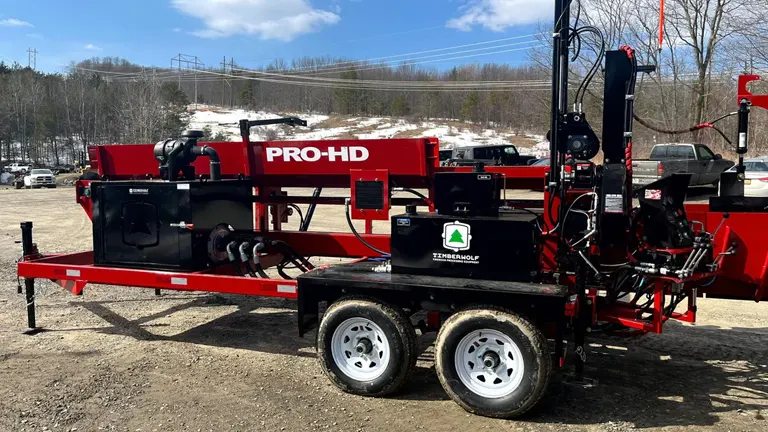
Convenience is at the forefront of the PRO-HD’s design. The hydraulic wedge lift and an 8-foot 3-strand live deck with hydraulic lift underscore Timberwolf’s commitment to efficiency and ease of use. These features, along with the processor’s integrated conveyor and reversible paddle belt, make the PRO-HD an asset for operators looking to increase their cord output without compromising on the quality or safety of their operations.
In sum, the Timberwolf PRO-HD stands as a paragon of medium-scale firewood processing equipment. Its combination of a high-power engine, innovative clamping and handling systems, and a user-friendly interface makes it an invaluable tool for those seeking to elevate their firewood processing to new heights of efficiency and profitability.
Large Scale: Timberwolf PRO-HD X
Quick Specifications
- Engine Power (HP): 56
- Pump Flow (GPM): 22-22-18
- Stroke (in): 26
- Trough Length (ft): 16
- Max Log Length (ft): 32
- Cycle Time (sec): 5.9/9.1
- Average Output (Cord/Hr): 2.5
- Weight (lbs): 9,200
Timberwolf’s PRO-HD X positions itself as the ideal solution for large-scale firewood processing needs. Standing out with its electric autocycle feature, it advances beyond the manual autocycle of the Pro-HD, streamlining operations for increased productivity. The machine is powered by a robust 56 HP Hatz diesel engine, which, along with a 3-stage Permco gear pump, energizes a suite of processing functions with unparalleled efficiency.
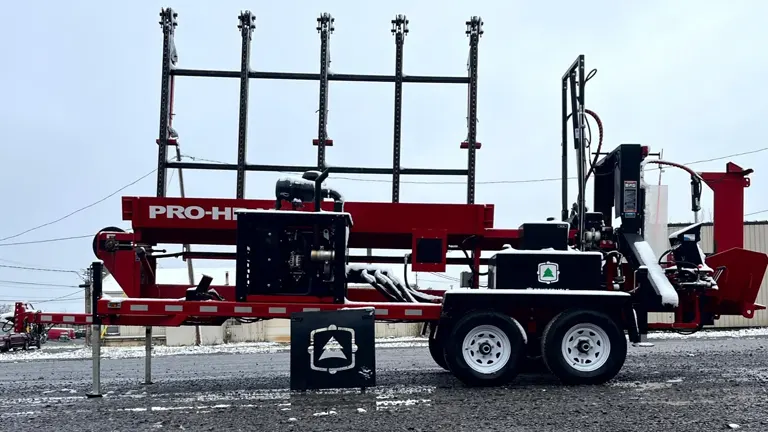
The PRO-HD X has been engineered to handle logs up to 32 feet with a 16-foot trough length, courtesy of Timberwolf’s patented top roll clamping system and the hourglass-shaped back roller. These features not only secure logs with a 1,000-pound downward pressure but also ensure precise cuts without the need for saw re-engagement. The back roller enhances log traction, allowing for straightforward adjustments and reducing the need for manual intervention. With a 70-gallon hydraulic tank, the processor is designed for all-day operation without the need for frequent breaks to cool the hydraulic fluid, a significant advantage for high-volume processing.
Timberwolf’s commitment to performance is reflected in the choice of hydraulic cylinders available for the PRO-HD X. Operators can select between a 4-inch cylinder, offering a swift 4.1-second cycle time, or a 5-inch cylinder, which provides more power for tougher logs with a 6.1-second cycle time. The processor’s impressive speed is attributed to the regeneration manifold and a 2:1 cylinder ratio, ensuring high cycle times and consistent splitting performance.
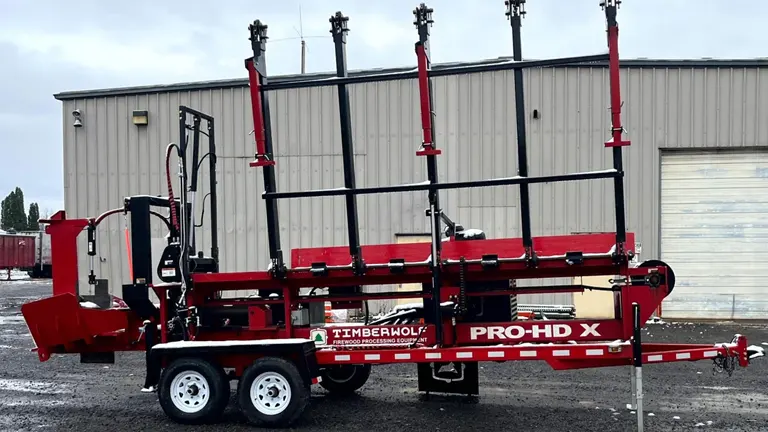
The versatility of the PRO-HD X is further enhanced by a range of wedge options, constructed from AR400 steel for maximum durability and resistance to wear. Safety remains paramount, with the processor utilizing Continental hoses known for their heavy-duty construction and pressure resistance, emphasizing Timberwolf’s priority on operator safety. With features like the hydraulic wedge lift, the process of adjusting for log size becomes hassle-free, allowing operators to efficiently manage logs of varying dimensions.
In conclusion, the Timberwolf PRO-HD X stands as a formidable contender in the firewood processing industry, particularly for large-scale operations seeking a balance of speed, power, and ease of use. Its electric autocycle, powerful hydraulic system, and advanced handling features come together to deliver a machine that not only maximizes output but also ensures quality and safety. With the PRO-HD X, Timberwolf once again proves that their machinery is not just about processing wood, but about enhancing productivity and profitability for their customers.
Industrial Scale: Timberwolf PRO-HD XL
Quick Specifications
- Engine Power (HP): 74
- Pump Flow (GPM): 33-18-14
- Stroke (in): 26
- Trough Length (ft): 16
- Max Log Length (ft): 32
- Cycle Time (sec): 3/4.5
- Average Output (Cord/Hr): 4
- Weight (lbs): 9,200
The Timberwolf PRO-HD XL stands as the pinnacle of the Pro-HD series, sharing the same robust frame as its siblings but with enhanced capabilities for industrial-scale operations. At the core of the PRO-HD XL is a commanding 74 HP Hatz diesel engine, which drives a three-stage Permco gear pump to deliver unparalleled performance in log splitting, sawing, and handling auxiliary functions. This pump grants a high flow of 33 GPM to the splitter and sufficient GPM to other vital components, ensuring that even the heaviest of logs can be processed with speed and precision.

The ingenuity of the PRO-HD XL lies in its hydraulic design, featuring a cycle time as rapid as 3 seconds with a 4-inch cylinder, making it one of the fastest processors in the market. For operators dealing with tougher, more resilient wood, the 5-inch cylinder option provides the necessary brute force, albeit with a slightly longer cycle time. The regeneration manifold, a hallmark of Timberwolf efficiency, complements the hydraulic system by speeding up the rod extension without increasing energy consumption, thus providing both rapid and energy-efficient cycle times.
Equipped to handle logs up to 32 feet long within a 16-foot trough, the PRO-HD XL’s patented top roll clamping system and hourglass-shaped back roller facilitate the handling of long logs with full security and minimal need for manual adjustments. This allows operators to process large volumes of wood without the pre-cutting stage, streamlining operations and saving valuable time. With a substantial 70-gallon hydraulic tank, the processor is designed for continuous operation, minimizing interruptions for cooling and ensuring consistent hydraulic performance.

Safety and durability are not an afterthought with Timberwolf’s processors. The PRO-HD XL utilizes Continental hoses, known for their resistance to high pressure, abrasions, and kinks, ensuring a safe and enduring performance. The flexibility of the system is showcased in the various wedge options constructed from AR400 steel, offering longevity and consistent quality through thousands of splits. Additionally, the processor’s hydraulic wedge lift simplifies adjustments, allowing for the seamless processing of varying log sizes without the need for manual alterations.
In conclusion, the Timberwolf PRO-HD XL is an industrial behemoth designed for relentless, high-volume firewood processing. Its powerful engine, fast cycle times, and innovative hydraulic system make it an indispensable asset for large-scale operations. With the PRO-HD XL, Timberwolf has once again demonstrated its commitment to delivering firewood processors that are not just powerful but are also efficient, safe, and operator-friendly, making it a top choice for businesses looking to maximize their output and efficiency.
Maintenance
Maintaining firewood processing equipment like those produced by Timberwolf is crucial to ensure their longevity, efficiency, and safety. Regular maintenance is essential to keep these machines running smoothly and to prevent unexpected breakdowns or accidents. Here’s a general guide on maintaining firewood processors:
- Daily maintenance is a critical step in ensuring the smooth operation of firewood processors. This involves a thorough inspection of the equipment to check for any loose bolts, potential hydraulic leaks, or parts that show signs of wear. Additionally, it’s important to clean the machine daily, removing any debris, sawdust, or wood chips that might have accumulated during the operation. Equally important is the lubrication of moving parts such as chains, bearings, and pivot points to ensure that they move smoothly and reduce the risk of wear and tear.
- Conducting weekly maintenance checks can significantly extend the lifespan of firewood processing equipment. These checks should focus on the hydraulic system, ensuring that fluid levels are adequate and there are no signs of leaks. Hydraulic fluid and filters should be changed as per the manufacturer’s recommendations. The cutting components, including the chainsaw or circular saw blade, should be regularly sharpened and adjusted for optimal performance, ensuring they are properly aligned for efficient and safe operation.
- Monthly maintenance tasks are essential for the long-term health of firewood processors. This includes inspecting conveyor belts for any signs of wear or damage and adjusting their tension as needed. It’s also crucial to check the condition of wedges and splitters, looking for any signs of damage or excessive wear. Safety features, such as guards and emergency stop mechanisms, should be tested regularly to ensure they function correctly and reliably.
- Seasonal maintenance typically involves a comprehensive inspection of the entire machine. This is the time to replace any parts that show significant wear or are close to failing. Additionally, applying protective coatings, such as rust protection or paint, to exposed metal surfaces can help prevent corrosion and extend the life of the equipment.
- Proper storage of firewood processing equipment is important, especially if it’s not going to be used for an extended period. The equipment should be stored in a covered, dry area to protect it from the elements. Before storage, it’s advisable to drain the fuel tank and disconnect the battery to prevent corrosion and other storage-related issues.
- Keeping a record of all maintenance activities is essential for effective equipment management. This log should include dates, details of the maintenance work carried out, and any parts that were replaced. Maintaining such a record helps in tracking the maintenance schedule, planning future maintenance activities, and identifying any recurring issues that may require attention.
- Lastly, it is vital to adhere to the manufacturer’s guidelines for maintenance. Every firewood processor model might have specific maintenance instructions and recommendations. Referring to the manufacturer’s manual ensures that maintenance is performed correctly and following the equipment’s design specifications. Using genuine parts for any replacements or repairs is also crucial to maintaining the integrity and performance of the machine.
Safety and Training Information
Safety and training are crucial aspects of operating firewood processors like those manufactured by Timberwolf. Given the nature of these machines, which involve cutting and splitting wood, ensuring operator safety and proper training is essential.
Safety Features of Firewood Processors
- Emergency Stop Mechanisms: These processors are equipped with emergency stop buttons or pull cords that allow the machine to be quickly shut down in case of an emergency.
- Protective Guards and Shields: Strategic placement of guards and shields helps prevent accidental contact with moving parts like the saw blade and splitting wedge.
- Lockout/Tagout Capabilities: To ensure safety during maintenance, these machines often include lockout/tagout systems to prevent accidental startup.
- Safety Interlocks: These prevent the machine from operating when certain conditions are not met, such as when a guard is open or a safety barrier is breached.
- Noise Reduction Features: Given the high noise levels typically produced by these machines, noise reduction features are important to protect operators’ hearing.
- Vibration Dampening: Continuous operation can lead to fatigue due to vibration, so these machines often have features to reduce vibration.
- Exhaust and Emission Controls: To ensure a safe working environment, especially indoors, processors are equipped with systems to manage exhaust and emissions.
Training Requirements
- Operator Training: Comprehensive training for operators is essential. This training should cover machine operation, understanding control systems, and emergency procedures.
- Maintenance Training: Regular maintenance is crucial for safe operation. Training should include routine checks, troubleshooting, and understanding when professional service is required.
- Safety Protocols: Operators should be trained in general safety protocols, including the correct use of personal protective equipment (PPE) such as gloves, safety glasses, hearing protection, and hard hats.
- Emergency Response Training: Training should also include emergency response procedures, such as how to use the emergency stop and how to act in case of a malfunction or accident.
- Certification: Depending on the region and the complexity of the equipment, certification may be required for operators.
- Ongoing Training: Refresher courses and ongoing training sessions help ensure that operators stay up to date with the latest safety practices and equipment updates.
FAQs
- What sets Timberwolf firewood processors apart from other brands in terms of durability and efficiency?
Discuss the unique engineering and design features that Timberwolf incorporates to enhance the durability and efficiency of their firewood processors. - How does Timberwolf ensure operator safety in their firewood processors?
Explore the specific safety features and mechanisms that Timberwolf includes in their machinery, emphasizing their commitment to operator safety. - Can Timberwolf firewood processors be customized for specific types of wood or cutting requirements?
Explain the adaptability of Timberwolf machines to different wood types and whether they offer customizable features for specific cutting and splitting needs. - What environmental considerations does Timberwolf take into account in the design of their firewood processors?
Delve into any environmentally friendly features or energy-efficient designs that Timberwolf incorporates into their machines. - How does Timberwolf support first-time users of firewood processors?
Information on training, customer support, and resources offered by Timberwolf for beginners who have never used a firewood processor before. - What is the average lifespan of a Timberwolf firewood processor and how can it be extended?
Provide insights into the typical durability of these machines and tips for maintenance practices that can prolong their lifespan. - How does the technology in Timberwolf firewood processors adapt to changes in the firewood industry?
Discuss how Timberwolf stays ahead of industry trends and continuously integrates new technologies into its products. - Can Timberwolf firewood processors be used in residential areas, or are they strictly for commercial use?
Clarify the range of Timberwolf products suitable for different environments, from residential to commercial scales. - What are the most common challenges users face with Timberwolf firewood processors and how are they addressed?
Highlight typical user challenges and the solutions or support Timberwolf provides to overcome these issues. - How does Timberwolf’s after-sales service and parts availability compare to industry standards?
Information on the availability of spare parts, service responsiveness, and how Timberwolf’s after-sales support stands out in the industry.

David Murray
Forestry AuthorI'm David Murry, a forestry equipment specialist with a focus on chainsaw operation. With over 13 years of experience, I've honed my skills in operating and maintaining a wide range of machinery, from chainsaws to log splitters. My passion for the outdoors and commitment to sustainable forestry drive my work, which emphasizes safety, efficiency, and staying updated with industry advancements. Additionally, I'm dedicated to sharing my expertise and promoting environmental awareness within the forestry community.

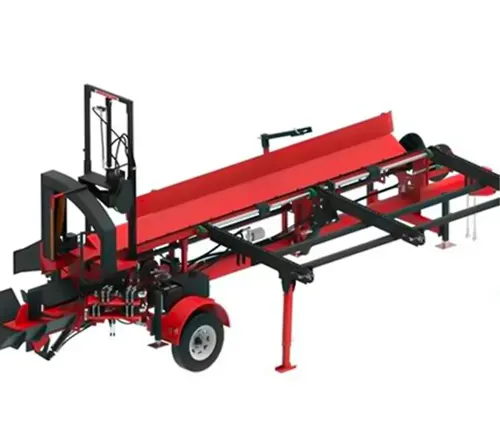
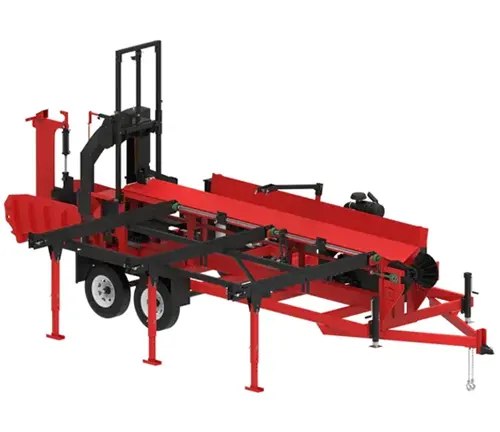

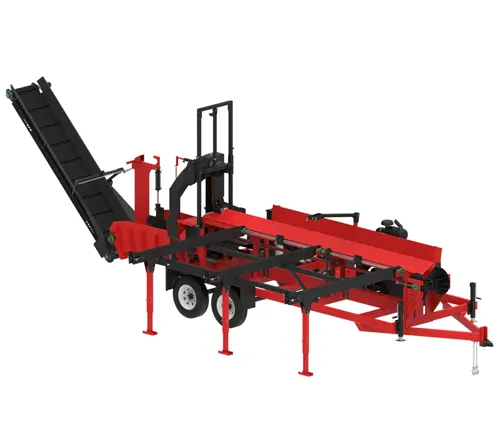
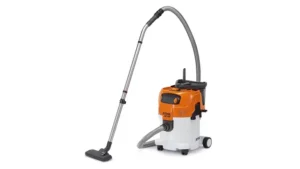

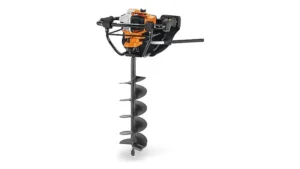

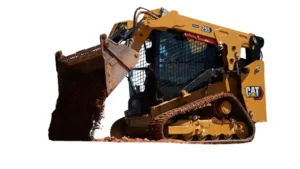
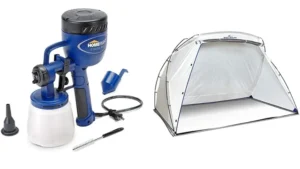

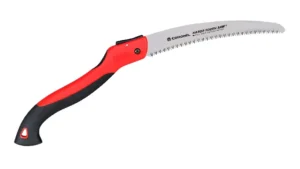
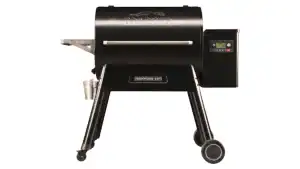
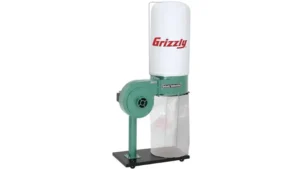
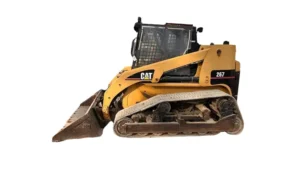
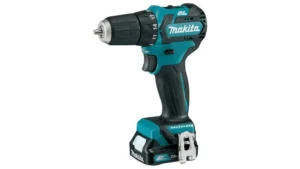
Leave your comment